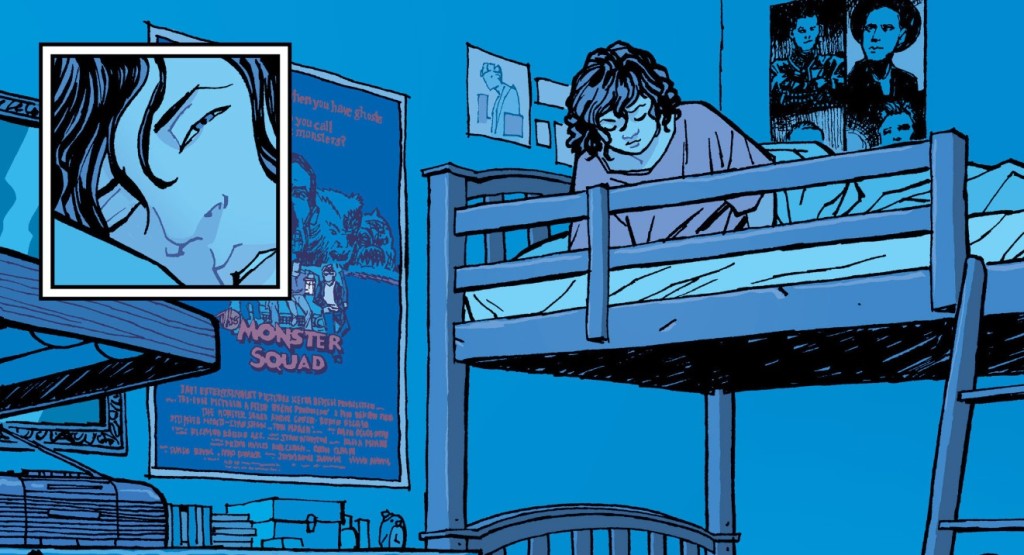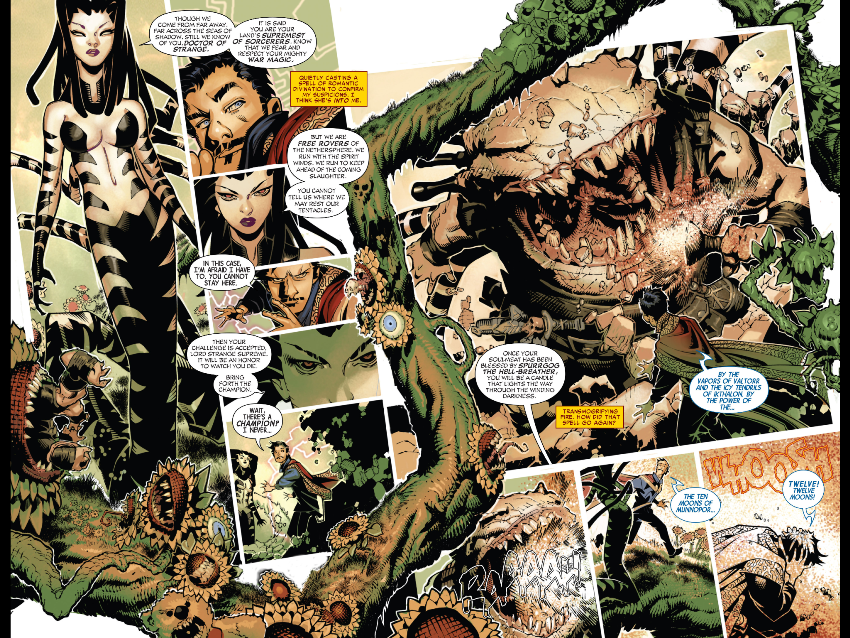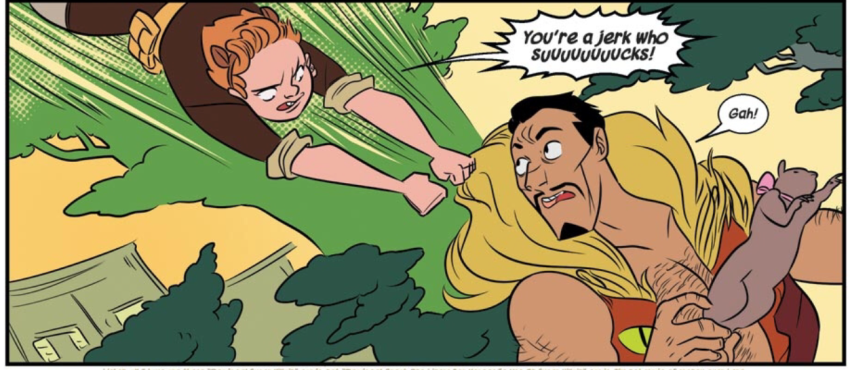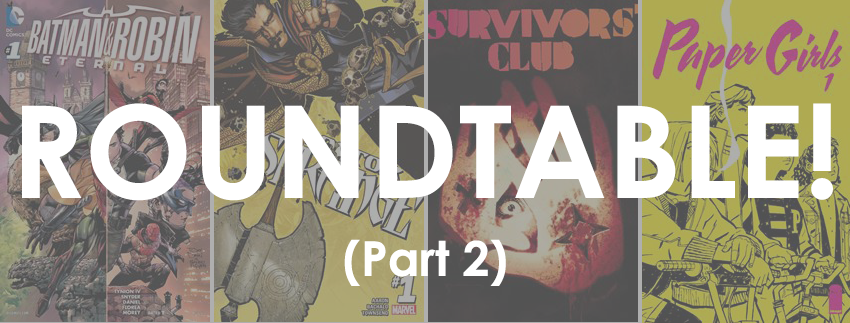
PREVIOUSLY, ON THE WAIT, WHAT? ROUNDTABLE. We started a look at four first issues: Batman & Robin Eternal #1 (DC), written by Scott Snyder and James Tynion IV with art from Tony Daniel; Survivors’ Club #1 (Vertigo), written by Lauren Beukes and Dale Halvorsen, with art from Ryan Kelly; Paper Girls #1 (Image), written by Brian K. Vaughan with art from Cliff Chiang; and Doctor Strange #1 (Marvel), written by Jason Aaron with art from Chris Bachalo and, in a backup story, Kevin Nowlan.
A bunch of other things happened.
And then Graeme asked Jeff and Matt what recent first issues had engendered genuine excitement.
MATT: I’m going to let Jeff take first crack at that question, but wanted to quickly respond, Graeme, to your mention of We Stand On Guard. Because I loved that book at the start—really, really liked it—and then liked the second issue, and kinda liked the third issue…and as of this week’s fourth issue, think I’m done with it altogether.
That’s what’s making me the most cautious about Paper Girls, honestly. Because on its merits alone, I liked that issue waaaaaaaaaaaaayyyyy more than either of you did, and if this were coming out straight off the back of Vaughan’s work on Saga and The Private Eye, I’d be pretty excited about the series as a whole. With WSOG in there…maybe not so much.
Now I’ve gotta figure out the last first issue that really worked for me; my wild disinterest in so much of Secret Wars (and that being a primary source of recent first issues) is making it harder than it should be. Jeff, what’ve you got?
JEFF: Hmm, while I figure that out, lemme just add that, honestly, everything Vaughan has done since, I dunno, the first issue or two of The Private Eye has made me more cautious about his work. But that first year of Saga, plus the early part of The Private Eye, really had me convinced we were seeing a dude take a leap to the next level.
As you mention, Matt, Vaughan is technically great—he and Ennis may be the best scripters in comics when it comes to pacing—but my faith in his ability to craft convincingly unique voices and an ability to build his narrative has been shaken by a lot of the stuff that comes since.
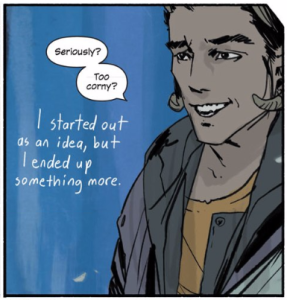 And so this at least gets me back to Graeme’s question, even as I rack my brain to come up with something a little more recent: I’m gonna go on a limb and say <<kanye>> “I’m sorry but Saga had one of the best first issues OF ALL TIME!” <</kanye>> That sucker is up there, beaten by Kirby’s OMAC #1 and maybe only very few others.
And so this at least gets me back to Graeme’s question, even as I rack my brain to come up with something a little more recent: I’m gonna go on a limb and say <<kanye>> “I’m sorry but Saga had one of the best first issues OF ALL TIME!” <</kanye>> That sucker is up there, beaten by Kirby’s OMAC #1 and maybe only very few others.
But as for more recent examples of great first issues? I’m looking over my reading list for 2015 and I think the three best first issues I read were Airboy #1, The Fiction #1, and The Black Hood #1, and, in manga, that first chapter of Assassination Classroom.
Hopefully that renders my tastes justifiably suspect: I know Abhay, for example, really thought that first issue of Bitch Planet is strong, and frankly I wrung my hands a lot over whether to include the first issue of Brubaker and Phillips’ The Fade Out, which I think is a great first chapter in what’s been (so far) a perfectly sustained narrative. But hopefully what it will do is also point out that a perfect first issue is no guarantee you’re going to hook me: Airboy stumbled badly in its second issue and although I’ve bought at least two more issues of The Fiction, I haven’t read them yet. Only The Black Hood and Assassination Classroom have me on the line, and I’m waiting for one to come back from hiatus, and reading the other through the library.
And I should point out that the most successful American indy comic of the last twenty years, The Walking Dead, doesn’t have an especially stunning first issue (though it’s perfectly in line with the rest of its narrative): I think it may well be the first trade of The Walking Dead that tantalizes you with a narrative engine the series does its best to deliver on.
As to the books at hand: I’m most interested in seeing the second issue of Survivors’ Club and if Lauren Beukes and Dale Halvorsen can change up their pacing enough to give their characters some actual character. And, sucker that I am, I’ll probably pick up the second issue of Batman & Robin Eternal, much against my better instincts: even though I thought the first Batman weekly book by and large didn’t deliver, and even though I arguably care even less about the hook of this storyline than I did about the one in the first issue of the first series, I think James Tynion IV did much stronger work with this issue than he did last year: writing a ton of comics appears to have sharpened his chops.
As for Paper Girls, I was pretty coolish about it, but apparently all it takes to buy me loyalty is sell me a 50 page comic for only $2.99. Things may be very different for me come 2016, but for now I’m perfectly okay trying at least two more regular-sized issues at that price point. I mean really, as you know, all you need to construct a perfect Jeff Lester trap is to craft a narrative that suggests you’ve read and are interested in ripping off Kazuo Umezu’s Drifting Classroom. I doubt Vaughan is gonna turn one of the girls into a half-monster, and have another one washed away by a horrible flash flood but…hey, a guy can dream, right? (Though honestly that Monster Squad poster on page 5 is probably closer to the mark.)
No, in the end, only Dr. Strange loses out on a second issue from me: Bachalo is a really interesting comparison/contrast with Ditko, especially in the push-and-pull between rigorous attention to design and loose, organic drawing, but Bachalo’s take on magical realms and creatures is more Dr. Seuss than Dr. Strange. Like Aaron’s take on magic, it’s fun but it’s not anything I really identify as Dr. Strange. And just as 50 pages for $2.99 buys a certain amount of good will from me, $4.99 for 28 pages does precisely the opposite.
Having blabbed ‘til my little blabber just couldn’t take it no more, did you guys come up with recent first issues that really worked for you? And are there any more of each other’s opinions we need to stampede over?
MATT: Dr. Strange actually left me really confused in my reaction to Bachalo’s art. Generally, I think I enjoy his work—it’s blocky and weird and kinetic and cartoony and all the things I usually like, and if the price for that is the occasional page where the action is relegated to the top-right corner while the center of the page is, for no discernible reason, an incredibly detailed vine wrapping around a mushroom with little trolls crawling all over it…well, so be it.
That’s how I was reacting as I read the lead story in Dr. Strange, just buzzing along with Bachalo’s weirdness as a pleasant harmonic counterpoint. Then I got to the Kevin Nowlan-drawn post-credit sequence and found myself SO RELIEVED by its straightforward clarity and easy-to-follow storytelling that I’m now wondering if I really enjoy Bachalo’s work at all.
ANYWAY, as you allude to, there are a lot of first issues that I enjoyed, but for ones that really worked…I’m honestly not sure. Like, Phonogram: The Immaterial Girl had a first issue that I really dug, but that enjoyment came in large part because it was the return of something I already knew. Thors and Weirdworld were both enjoyable Secret Wars tie-ins, but (much like Dr. Strange) they both left me thinking “Man, I sure will enjoy these when they hit Unlimited”. The Omega Men, maybe? That was intriguing and interesting and enjoyable and has me onboard for all the issues to date.
To be fair to all these things I’m mentioning, though, maybe we’re holding them to a needlessly high and arbitrary standard. I got a review copy of the first issue of Telos from DC this week, and that thing was such a hot mess that I feel ridiculous criticizing an ambitious, well-intentioned work like Survivors’ Club.
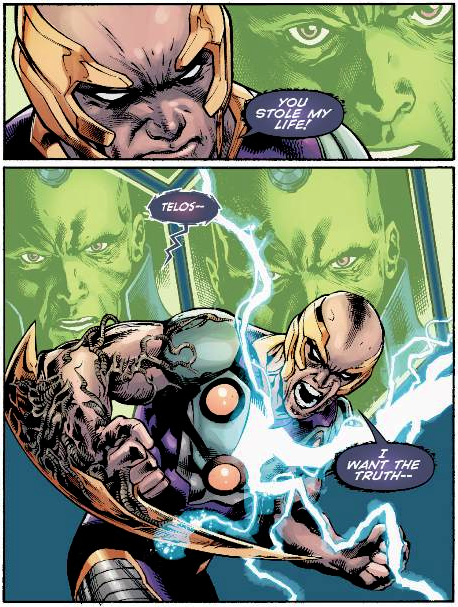 Telos #1 reads like a parody of sci-fi superhero comics written by someone who has heard them described, poorly, by a distracted seven year-old. It features such scintillating dialogue as “I, Computo, great operator of the gateway through which the stream of our common integrity is shared, bring the rebels before you for judgment.” The art is, like so much of DC’s output these days, in their house style: slightly stiff, slightly over-rendered, slightly too full of gritted teeth and shouty men. It is barely a first issue, as it is totally dependent on familiarity with the Convergence series; I haven’t read that, and (likely as a result), this book failed for me on just about every conceivable level.
Telos #1 reads like a parody of sci-fi superhero comics written by someone who has heard them described, poorly, by a distracted seven year-old. It features such scintillating dialogue as “I, Computo, great operator of the gateway through which the stream of our common integrity is shared, bring the rebels before you for judgment.” The art is, like so much of DC’s output these days, in their house style: slightly stiff, slightly over-rendered, slightly too full of gritted teeth and shouty men. It is barely a first issue, as it is totally dependent on familiarity with the Convergence series; I haven’t read that, and (likely as a result), this book failed for me on just about every conceivable level.
Compared to Telos #1, B&RE #1 is a master class in how to launch a series. What do you guys think? Is it possible we’re being overly demanding?
GRAEME: Is it really over-demanding for a first issue to get us excited about a series? If so, then I think we’re in a bad place for many, many reasons. And, as much as the central Convergence series ended up being an odd guilty pleasure for me, Telos #1 was a mess of a debut; if we’re really looking at horrible books as a baseline and grading upwards from there, I think we’re doing something wrong. Maybe this is me being the Internet’s Curmudgeon again, mind you.
I’m trying to think about first issues that wowed me recently. The Omega Men, sure—but that might fail in terms of the whole “setting everything up and delivering on the hook” angle, instead substituting an obvious mystery in place with appropriate style. The Unbeatable Squirrel Girl won me over entirely with its first issue, too, but again, that’s as much on style as substance (Although it actually really does manage to introduce everything properly in its short space as well; it’s just that that book’s charming as hell, and I love it for its personality as much as any plot reveal).
I feel as if I’m unraveling my own theories about what makes a good first issue right now. Perhaps it’s not that I’m looking for a coherent unveiling of the series’ high concept, but a sense that the creative team know what they’re doing and are capable of doing it?
Southern Bastards #1! I loved that one, and that feels like proof of my new take on things; it’s a very individual book, and something so wonderfully bold and unapologetic that you’re left feeling as if it’s very much it’s own thing. By contrast, this new idea also explains why I’m down on the company-owned books so much, because—well, they’re company-owned, and those books can be undercut at any possible moment. Hrm.
Jeff, save me from my own indecision!
JEFF: I wish I could, but I mostly agree and I also mostly think it’s a good thing. Even looking at it from the most blinkered and Big Two-centric side of things (which I also worry is a shockingly short space from where I live), the idea that an indy book like Southern Bastards makes us raise our standards for a first issue is a good thing. It means there’s less complacency, less acquiescence, in our reading of first issues from the Big Two. Comparing something like Batman & Robin Eternal to Southern Bastards instead of Telos will probably be better for everyone in the long run.
And, in theory, that means books from Marvel and DC have to do more than rely on our interest in characters we already know, or creators we already like. I didn’t include Squirrel Girl in my list literally because I missed the first issue and started at issue #2 or #3, but it’s a good example of a book that, like The Omega Men or Ms. Marvel, is genuinely bold and genuinely different.
That all of those books are a year old or less is maybe a sign that work like Copra and Revenger and The Wicked + The Divine and Bitch Planet and Criminal are making the Big Two do more, at least on the side from their main game, which is getting John Cassaday on an opening arc and promising, “this is {character] like you’ve never seen {character] before,” promising literally exactly the same but (“all new, all”) different.
As it stands, we’re not entirely free from the dangers of a publisher like Image doing the same thing, like a few Expos ago when it seemed every other announcement was “hey, it’s Matt Fraction doing science fiction like you’ve never seen science fiction before” or “here’s Scott Snyder doing a horror comic, here’s Robert Kirkman doing a horror comic, and holy crap wait until you see Rick Remender’s horror comic.” If there is a science to launching a new book, it’s not going to be mistaken for quantum physics any time soon.
But looking at what I read, I do feel no small part of responsibility for that. If I’m going to praise The Fiction but then stop reading it at issue #3, and continue to buy a weekly Batman book that’s just a half-step above frenzied gibberish, what message am I sending comics publishers?
WHAT MESSAGE INDEED, JEFF LESTER?!?!? Perhaps we will all find out in Part 3 of this very roundtable! Probably not, but you never know.
